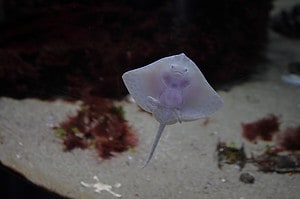There are around 30 species of giant freshwater fish in the world. But, the world’s largest freshwater fish ever captured looks nothing like a trout or a salmon. In fact, the previous record-holder was a Mekong giant catfish that weighed 646 pounds, caught in 2005. But, as of 2022, we have a new record holder for the largest freshwater fish ever caught—a Mekong giant stingray. Stingrays live in both fresh and saltwater; they’re closely related to sharks. Few freshwater fish can compare to the largest giant stingrays pulled from the Mekong River in Cambodia and Thailand.
Let’s take a closer look at the new record holder for largest freshwater fish ever discovered. We’ll learn more about giant freshwater stingrays, and how their numbers are indicative of the overall health of the extremely biodiverse Mekong River. We’ll learn about the greatest threats to these river giants, and what you can do to help ensure they don’t disappear.
The World’s Largest Freshwater Fish—Caught in 2022
On June 13, 2022, a Cambodian fisherman named Moul Thun unwittingly reeled in a creature larger than any other previously discovered freshwater fish. The stingray on the end of his line turned out to be a Mekong giant freshwater stingray—the largest species of freshwater fish on Earth. But, this female stingray isn’t just large, she’s exceptionally large.
The previous record for world’s largest freshwater fish was a Mekong giant catfish that weighed 646 pounds. The stingray, who locals named ‘Boramy’, which means ‘full moon’ in Khmer, weighed in at a whopping 661 pounds. More than that, she measured 13 feet long from snout to tail, making Boramy the largest freshwater fish ever discovered.
What Happened to Boramy?

In Khmer, Boramy means ‘full moon’. Given her shape, it’s easy to see where the giant stingray’s name came from.
©Danny Ye/Shutterstock.com
Moul Thun must have known that he had something really special on the end of his line, because as soon as he hauled the giant stingray in, he called Wonders of the Mekong. Wonders of the Mekong is a conservation group dedicated to gaining a better understanding of the Mekong River and preserving it, and its giant inhabitants, for future generations. Within hours, scientists from Wonders of the Mekong arrived at Kaoh Preah, in Northern Cambodia.
From there, they weighed, measured, and tagged Boramy with a special tracker. Both scientists and locals worked to keep her calm and in the water as much as possible. And, when they were done with all the record-breaking measurements, they released Boramy back into the murky depths of the Mekong River. In exchange for releasing this river giant, Moul Thun was paid about $600—the going rate for a fish that size.
So, Boramy, the world’s largest freshwater fish, still swims free. Scientists hope that her presence indicates that all hope is not lost for the Mekong River and its incredible fish.
The Giant Freshwater Stingray

Giant freshwater stingrays live exclusively in freshwater, and are therefor classified as freshwater fish. Some giant fish live in both fresh and saltwater, and do not count as true freshwater fish.
©iStock.com/slpu9945
Known as Himantura chaophraya to the scientific world, the giant freshwater stingray lives in Southeast Asia and Indonesia. Only in the rivers of Southeast Asia do they grow to gigantic proportions. But, these rays have only been known to scientists since 1990. Scientists have known about giant freshwater stingrays for decades now, yet little is known about these gentle giants.
Giant freshwater stingrays have round, flat bodies with long whip tails. Their eyes are on the tops of their bodies, and their jaws are on the bottom. But, stingray teeth aren’t like any other teeth on the planet. They’re designed to suck in bottom-dwelling creatures, like crabs, fish, and clams, and grind them up like knobby steam rollers. Giant stingrays also have barbs on their tails for injecting venom, though injuries to humans are exceedingly rare.
Threats to Mekong Giant Stingrays

Today, thanks to the efforts of conservation groups, local fisherman often call in scientists when they hook a true giant, rather than killing and selling it.
©Mekong on tour/Shutterstock.com
The Mekong River is one of the most biodiverse places on the planet. Scientists believe that over 200 billion fish spawn there every year. It runs through China, Myanmar, Laos, Cambodia, Thailand, and Vietnam. It is the only river on Earth that hosts the world’s largest freshwater fish. Decades ago, locals say that giant fish—including Mekong giant stingrays—were much more plentiful. Today, a combination of factors has led to a critical juncture for the Mekong River.
A combination of pollution, overfishing, dam building, saltwater intrusion, and sediment depletion have significantly impacted the Mekong River’s health. The Mekong River is home to the third most diverse fish population on Earth. Globally, 70% of all giant freshwater fish are in danger of going extinct, and 100% of the giant freshwater fish in the Mekong river face this possibility. Giant freshwater stingrays are listed as critically endangered.
Scientists with Wonders of the Mekong hope that Boramy’s presence is an indication that the river’s health is rebounding, at least a little. They’ve been working for years with local fishermen to compile data on the giants of the Mekong River. They hope that Boramy’s tracking device will provide even more invaluable data.
What Can You Do to Support Global Biodiversity?

The Mekong
River is the third-longest river in Asia
, it’s also one of the most dammed rivers in the world.
©Mike Towers/Shutterstock.com
The first step in doing your part to support global biodiversity is simply taking an interest. When you read headlines about the world’s largest freshwater fish, consider what kinds of threats that species faces, and whether there’s anything you can do on a personal level to mitigate those threats.
Educate yourself about conservation, and the primary threats to global biodiversity. Be mindful of the consequences of your actions. Whether it’s recycling, planting bee-friendly flowers, or driving less, there are many ways that you can make a difference.
The photo featured at the top of this post is © Mekong on tour/Shutterstock.com
Thank you for reading! Have some feedback for us? Contact the AZ Animals editorial team.






